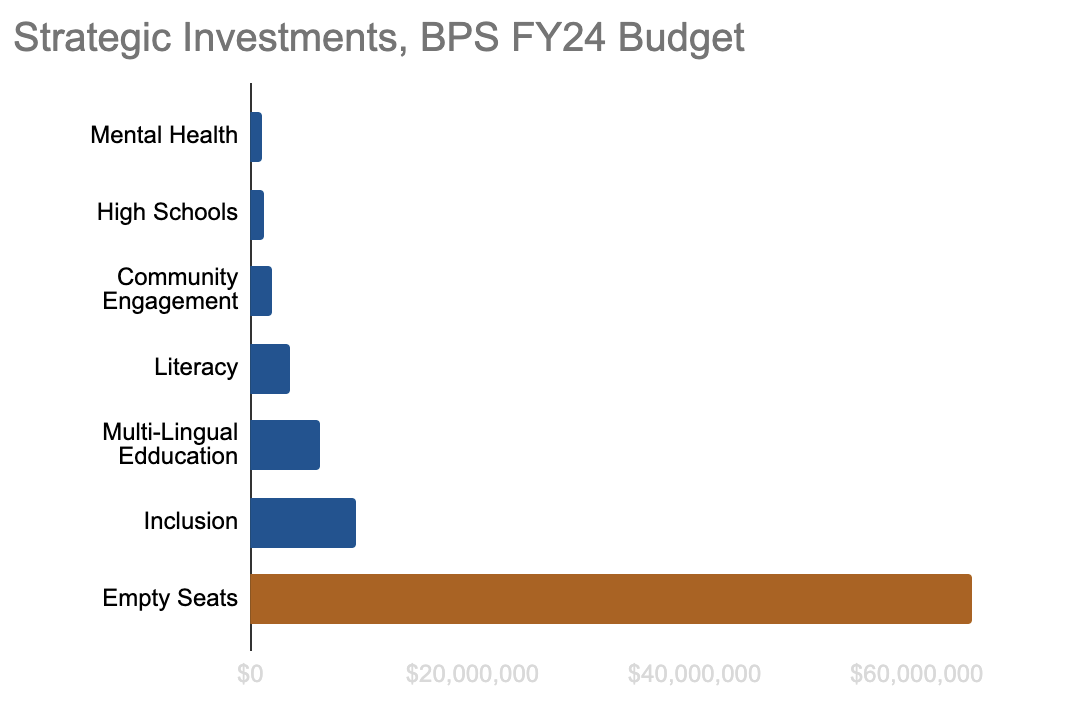FYI from BSF, 02.03.23
The multi-month process of the Boston Public Schools (BPS) budget began Wednesday night at the Boston School Committee meeting. With large numbers, initiatives, memos and acronyms, there is a lot to digest as the budget makes its way through Boston School Committee, public hearings, and a final City Council vote in June. Here are three early headlines.
1. There is a lot more money.
For many years, Boston has spent more on its schools than almost every other major city in America.
That trend has accelerated recently. Starting with then Mayor Walsh, and extended by now Mayor Wu, the city has increased and sustained school spending by an additional $175M.
To put that into perspective, that increase alone is greater than the entire budget of ~98% Massachusetts school districts.
And this doesn’t even take into account federal funding. In addition to the annual grants for poverty, education, and teacher supports, FY24 will feature the last tranche of more than ~$450M federal stimulus dollars (orange below).
Despite the headlines and focus on the city’s contribution, federal and state dollars bring the total budget to more than $1.8B (page 20, last line). The real per-pupil expense is $37,056.
Educating a child in Boston now carries more investment than a year of tuition, room, and board at UMass.
2. The priorities are clear.
The largest share of the new funding goes to increases to existing costs. 73 cents of each new dollar will go to teacher salary increases, transportation, special education, etc.
What remains goes to the six areas that Superintendent Skipper has consistently communicated since assuming the role in September:
3. There is no plan for sustainability beyond next year.
There is one less explicitly named priority in the budget and it goes by many names. “Enrollment capacity.” “Soft landings.” “Hold-harmless.”
In other words: empty seats.
The dramatic decline in enrollment in BPS since 2014 has resulted in buildings that are not full of students. Despite the analysis and language in its own budget memo, BPS is projecting slight increase in enrollment next year.
BPS follows a “weighted student formula.” funding schools based on how many students are enrolled and their needs. BPS has to spend more and more dollars each year to maintain staffing and programs at schools that are not fully enrolled - which is most of them now (see this table). The terminology and sources of revenue changed this year, but empty seats have grown to be ~$65M of the BPS budget this year.
At that rate, investment in empty seats dwarfs any proposed strategic investment.
In the short run, there is a good case to be made to sustain programming. But what happens when the extra money runs out?
That is not hypothetical. This will happen next year when the federal stimulus dollars run out. Further, BPS changed its policies to explicitly use those federal dollars to cover the cost for empty seats next year. Put aside questions you may have around strategic implications (literacy, tutoring, extended day or year, etc.), and a more urgent one arises: how can we sustain schools and programs beyond this year?
Budgets aren't magic. You need to bring in more money (BPS: “identify sustainable funding sources”) or you need to change how/how much you spend money (BPS: “reimagined funding policy”).
No clear answers yet.
Notes in the Margin
In case you missed it, public schools are closed in Boston today.
The continued teacher strike, not the cold air, closed Woburn schools again today. The backdrop for the latest labor unrest is the stated legislative goal of the Massachusetts Teacher’s Association to legalize strikes (and end state interventions, MCAS, etc.). Governor Healey declined to support teacher strikes when asked. Still, the stakes here seem small compared to the nationwide teacher strike in England right now.
Monday’s massive fight and stabbings outside of Tech Boston are sure to continue to raise debate around the nature of and response to safety issues in schools.
Sunday’s shooting of a Norwood 13-year old has a Boston connection beyond its location in Mattapan: Tyler Lawrence attended Boston Public Schools until his family moved mid-pandemic.
In his first public address at the annual Conditions of Education event (data here), Secretary of Education Pat Tutwiler shared his vision for the new administration. Former Secretary of Education Jim Peyser reflects on the last one.
Curious about teacher data in Massachusetts? There is a dashboard for that.
Massachusetts vocational schools are subject to a civil rights complaint.
The tensions around curriculum in schools (this week’s edition: AP standards) is not just playing out in the media and amongst politicos - it is affecting schools.
Interrupted learning is a worldwide problem - delays in acquiring academic skills cuts across 15 countries.
PK-12 academic preparation narrows (or widens) college disparities.
Four of the 20 most expensive counties for child care are in Massachusetts.
Other Matters
His right ankle kept him off the court again this week, but not out of school. Marcus Smart at Boston Collegiate.








